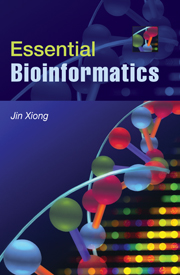Book contents
- Frontmatter
- Contents
- Preface
- SECTION I INTRODUCTION AND BIOLOGICAL DATABASES
- SECTION II SEQUENCE ALIGNMENT
- SECTION III GENE AND PROMOTER PREDICTION
- SECTION IV MOLECULAR PHYLOGENETICS
- SECTION V STRUCTURAL BIOINFORMATICS
- SECTION V GENOMICS AND PROTEOMICS
- 17 Genome Mapping, Assembly, and Comparison
- 18 Functional Genomics
- 19 Proteomics
- APPENDIX
- Index
- Plate section
- References
18 - Functional Genomics
Published online by Cambridge University Press: 05 June 2012
- Frontmatter
- Contents
- Preface
- SECTION I INTRODUCTION AND BIOLOGICAL DATABASES
- SECTION II SEQUENCE ALIGNMENT
- SECTION III GENE AND PROMOTER PREDICTION
- SECTION IV MOLECULAR PHYLOGENETICS
- SECTION V STRUCTURAL BIOINFORMATICS
- SECTION V GENOMICS AND PROTEOMICS
- 17 Genome Mapping, Assembly, and Comparison
- 18 Functional Genomics
- 19 Proteomics
- APPENDIX
- Index
- Plate section
- References
Summary
The field of genomics encompasses two main areas, structural genomics and functional genomics (see Chapter 17). The former mainly deals with genome structures with a focus on the study of genome mapping and assembly as well as genome annotation and comparison; the latter is largely experiment based with a focus on gene functions at the whole genome level using high throughput approaches. The emphasis here is on “high throughput,” which is simultaneous analysis of all genes in a genome. This feature is in fact what separates genomics from traditional molecular biology, which studies only one gene at a time.
The high throughput analysis of all expressed genes is also termed transcriptome analysis, which is the expression analysis of the full set of RNA molecules produced by a cell under a given set of conditions. In practice, messenger RNA (mRNA) is the only RNA species being studied. Transcriptome analysis facilitates our understanding of how sets of genes work together to form metabolic, regulatory, and signaling pathways within the cell. It reveals patterns of coexpressed and coregulated genes and allows determination of the functions of genes that were previously uncharacterized. In short, functional genomics provides insight into the biological functions of the whole genome through automated high throughput expression analysis. This chapter mainly discusses the bioinformatics aspect of the transcriptome analysis that can be conducted using either sequence- or microarray-based approaches.
- Type
- Chapter
- Information
- Essential Bioinformatics , pp. 261 - 280Publisher: Cambridge University PressPrint publication year: 2006



